An All-Sky Scattering Index Derived from Microwave Sounding Data at Dual Oxygen Absorption Bands
Abstract
:1. Introduction
2. Instruments and Data Sets
2.1. Microwave Sounding Instruments Onboard FY-3D
2.2. Global Precipitation Measurement (GPM)
3. Methodology
3.1. Description of CESI Method
3.2. Limb Correction Algorithm
4. Analysis and Validation
4.1. Analysis
4.2. Validation on the Spatial Distribution
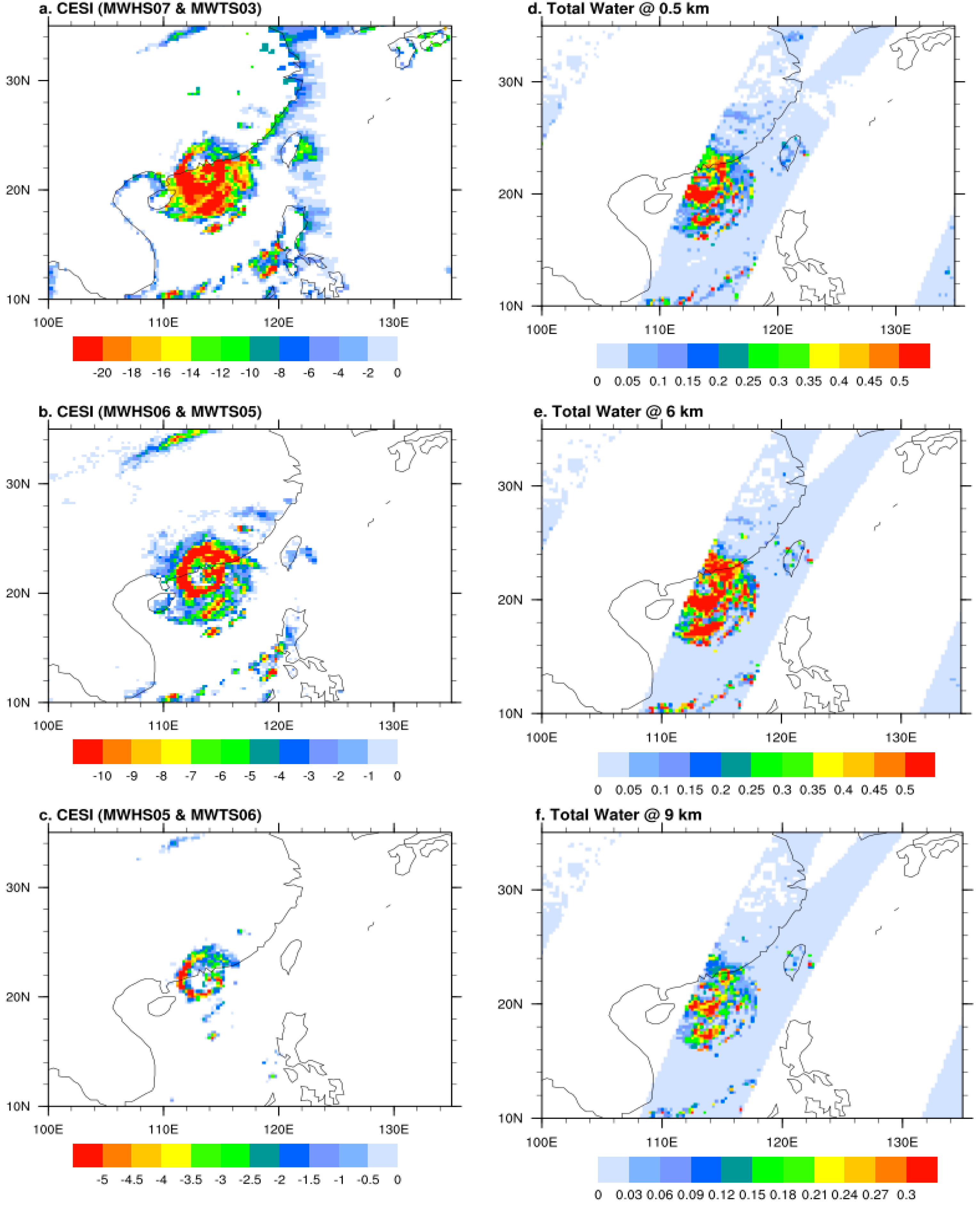
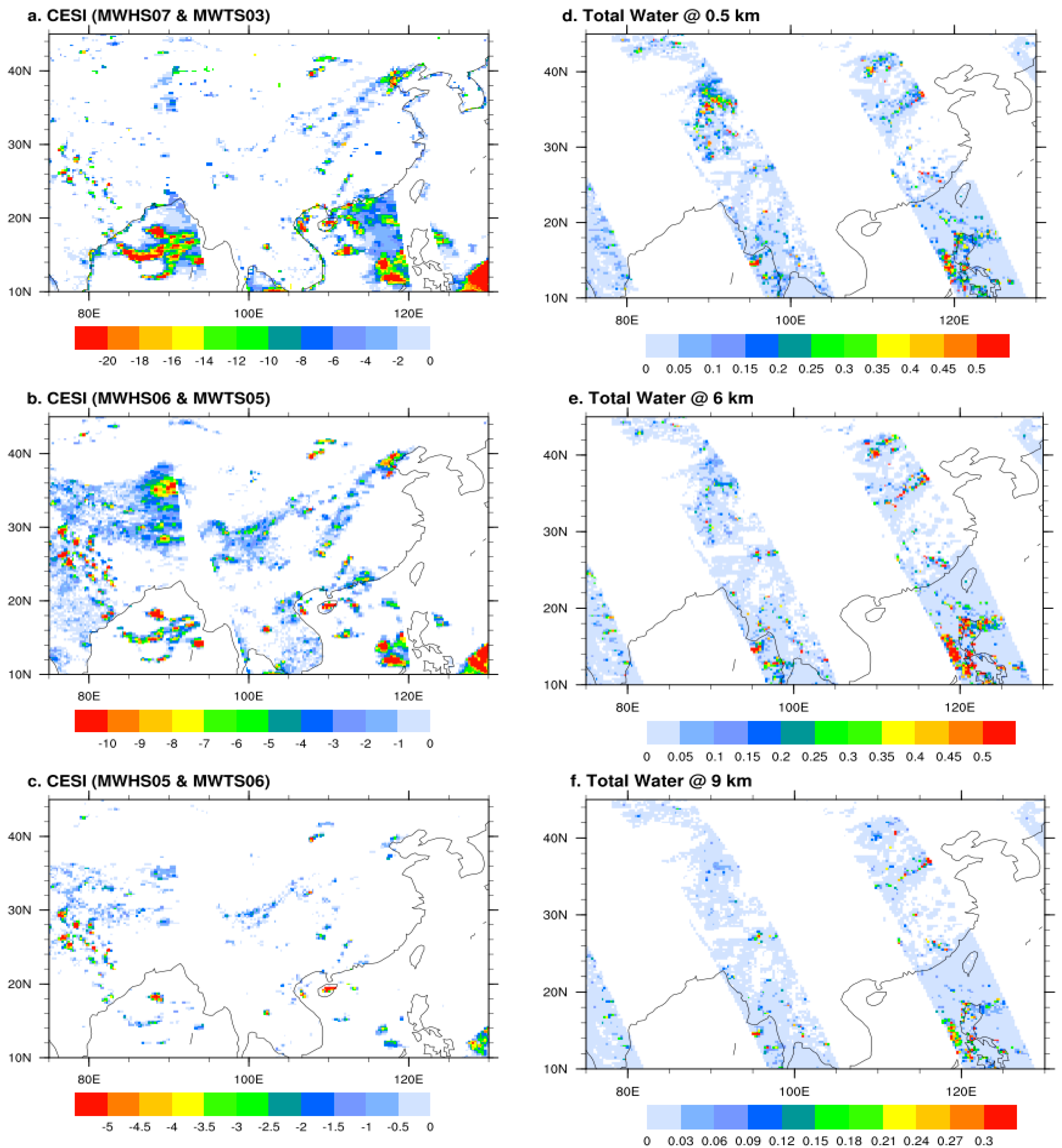
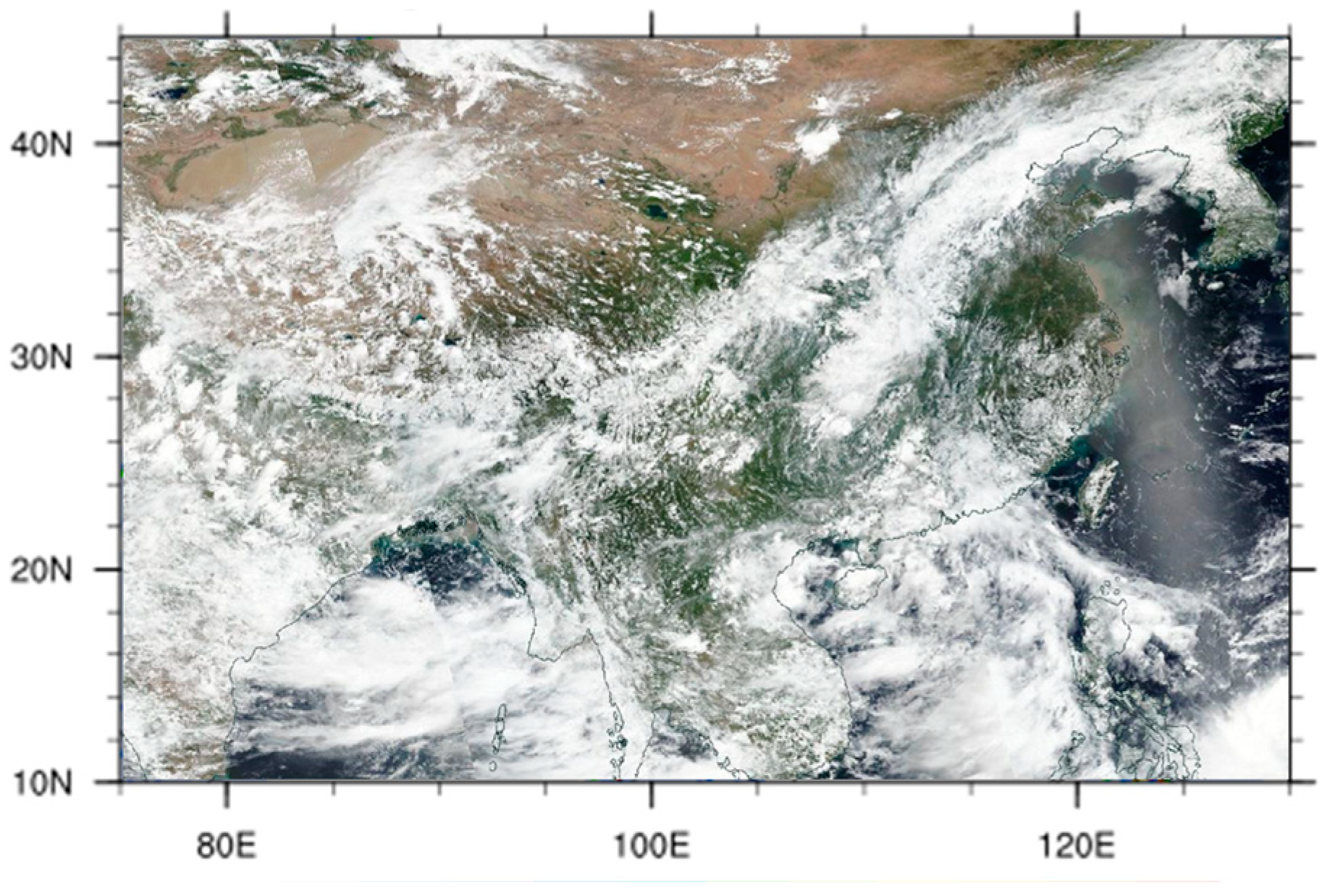
4.3. Validation of Verical Distribution
4.4. Discussion on Cloud Detection Thresholds
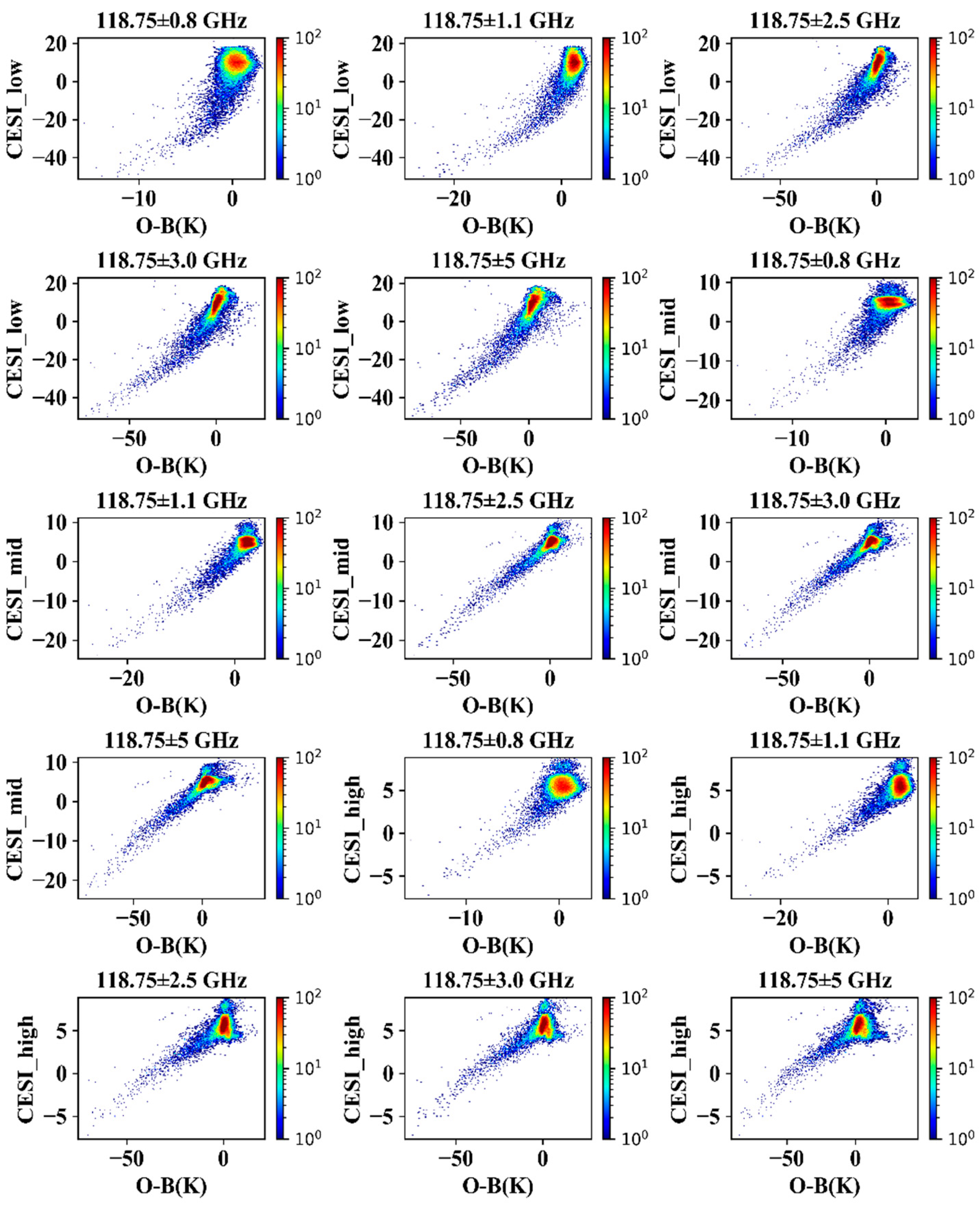
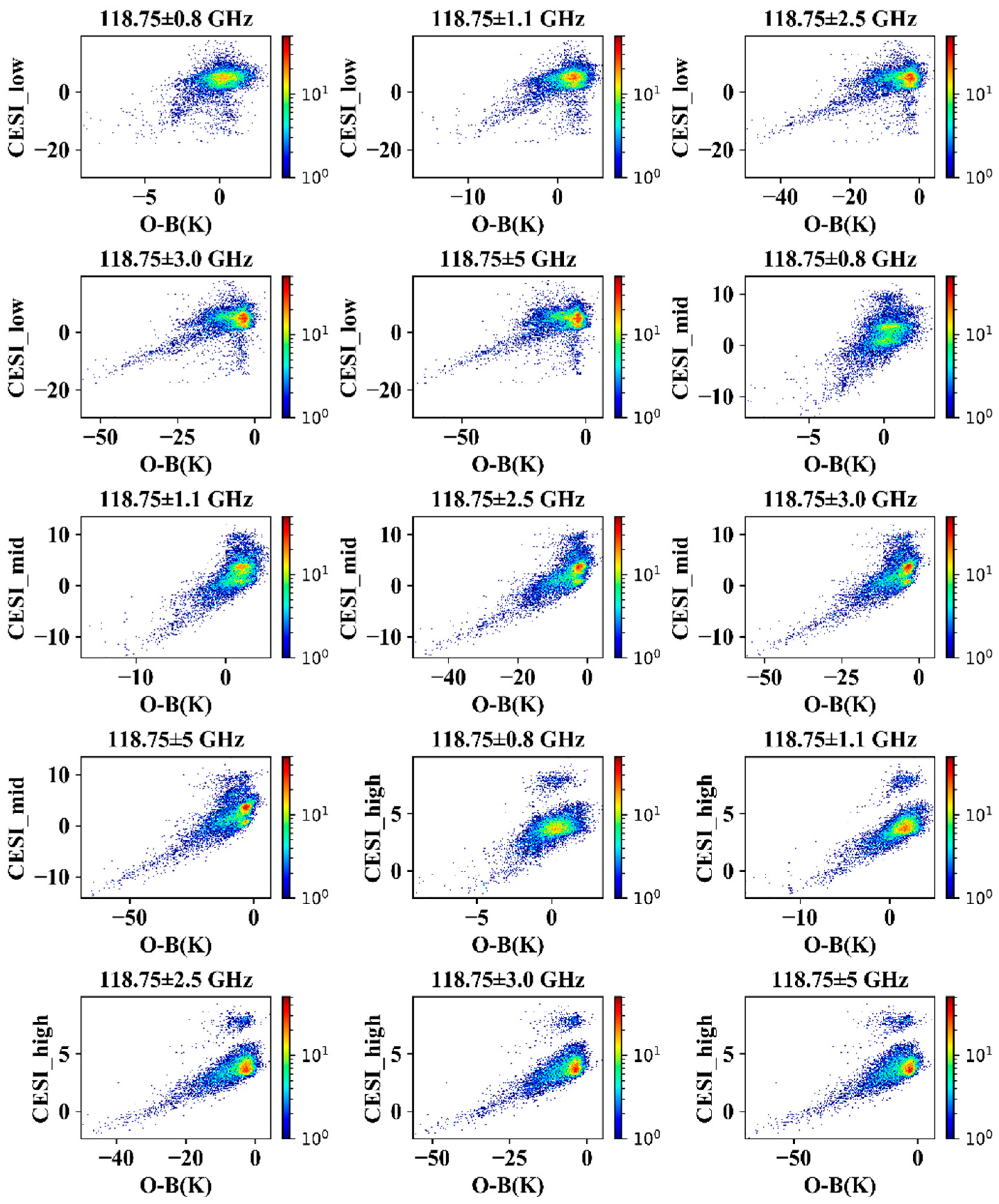

5. Conclusions
Author Contributions
Funding
Data Availability Statement
Acknowledgments
Conflicts of Interest
References
- Migliorini, S.; Candy, B. All-sky satellite data assimilation of microwave temperature sounding channels at the Met Office. Q. J. R. Meteorol. Soc. 2019, 145, 867–883. [Google Scholar] [CrossRef]
- Kan, W.; Han, Y.; Weng, F.; Guan, L.; Gu, S. Multisource Assessments of the FengYun-3D Microwave Humidity Sounder (MWHS) On-Orbit Performance. IEEE Trans. Geosci. Remote Sens. 2020, 58, 7258–7268. [Google Scholar] [CrossRef]
- Carminati, F.; Atkinson, N.; Candy, B.; Lu, Q.F. Insights into the microwave instruments onboard the Feng-Yun 3D satellite: Data quality and assimilation in the Met Office NWP system. Adv. Atmos. Sci. 2020, 38, 1379–1396. [Google Scholar] [CrossRef]
- Li, J.; Zou, X. A quality control procedure for FY-3A MWTS measurements with emphasis on cloud detection using VIRR cloud fraction. J. Atmos. Ocean. Technol. 2013, 30, 1704–1715. [Google Scholar] [CrossRef] [Green Version]
- Han, H.; Li, J.; Goldberg, M.; Wang, P.; Li, J.; Li, Z.; Sohn, B.-J.; Li, J. Microwave Sounder Cloud Detection Using a Collocated High-Resolution Imager and Its Impact on Radiance Assimilation in Tropical Cyclone Forecasts. Mon. Weather Rev. 2015, 144, 3937–3959. [Google Scholar] [CrossRef]
- Qin, Z.; Zou, X. Uncertainty in Fengyun-3C microwave humidity sounder measurements at 118 GHz with respect to simulations from GPS RO data. IEEE Trans. Geosci. Remote Sens. 2016, 54, 6907–6918. [Google Scholar] [CrossRef]
- Grody, N.; Zhao, J.; Ferraro, R.; Weng, F.; Boers, R. Determination of precipitable water and cloud liquid water over oceans from the NOAA 15 advanced microwave sounding unit. J. Geophys. Res. 2001, 106, 2943–2953. [Google Scholar] [CrossRef]
- Weng, F.; Zhao, L.; Ferraro, R.; Poe, G.; Li, X.; Grody, N. Advanced microwave sounding unit cloud and precipitation algorithms. Radio Sci. 2003, 38, 8068. [Google Scholar] [CrossRef]
- Ji, D.; Shi, J.; Xiong, C.; Wang, T.; Zhang, Y. A total precipitable water retrieval method over land using the combination of passive microwave and optical remote sensing. Remote Sens. Environ. 2017, 191, 313–327. [Google Scholar] [CrossRef]
- Bennartz, R.; Thoss, A.; Dybbroe, A.; Michelson, B. Precipitation analysis using the Advanced Microwave Sounding Unit in support of nowcasting applications. Meteorol. Appl. 2002, 9, 177–189. [Google Scholar] [CrossRef]
- Lin, L.; Zou, X.; Weng, F. Combining CrIS double CO2 bands for detecting clouds located in different layers of the atmosphere. J. Geophys. Res. Atmos. 2017, 122, 1811–1827. [Google Scholar] [CrossRef]
- Wang, L.; Tian, M.; Zheng, Y. Assessment and improvement of the Cloud Emission and Scattering Index (CESI)–an algorithm for cirrus detection. Int. J. Remote Sens. 2019, 40, 5366–5387. [Google Scholar] [CrossRef]
- Han, Y.; Zou, X.; Weng, F. Cloud and precipitation features of Super Typhoon Neoguri revealed from dual oxygen absorption band sounding instruments on board FengYun-3C satellite. Geophys. Res. Lett. 2015, 42, 916–924. [Google Scholar] [CrossRef]
- Hu, H.; Weng, F. Influences of 1DVAR Background Covariances and Observation Operators on Retrieving Tropical Cyclone Thermal Structures. Remote Sens. 2022, 14, 1078. [Google Scholar] [CrossRef]
- Lawrence, H.; Carminati, F.; Bell, W.; Bormann, N.; Newman, S.; Atkinson, N.; Geer, A.J.; Migliorini, S.; Lu, Q.; Chen, K. An Evaluation of FY-3C MWRI and Assessment of the Long-Term Quality of FY-3C MWHS-2 at ECMWF and the Met Office; European Centre for Medium-Range Weather Forecasts: Reading, UK, 2017; Available online: https://www.ecmwf.int/sites/default/files/elibrary/2017/17206-evaluation-fy-3c-mwri-and-assessment-long-term-qualityfy-3c-mwhs-2-ecmwf-and-met-office.pdf (accessed on 23 October 2022).
- Matsui, T.; Iguchi, T.; Li, X.; Han, M.; Tao, W.-K.; Petersen, W.; L’Ecuyer, T.; Meneghini, R.; Olson, W.; Kummerow, C.D.; et al. GPM Satellite Simulator over Ground Validation Sites. Bull. Am. Meteorol. Soc. 2013, 94, 1653–1660. [Google Scholar] [CrossRef]
- Iguchi, T.; Seto, S.; Meneghini, R.; Yoshida, N.; Awaka, J.; Kubota, T. GPM/DPR Level-2 Algorithm Theoretical Basis Document. Available online: http://pmm.nasa.gov/sites/default/files/document_files/ATBD_GPM_DPR_n3_dec15.pdf (accessed on 23 October 2022).
- Jackson, G. NASA’s Global Precipitation Measurement (GPM) Mission for Science and Society. In Proceedings of the Egu General Assembly Conference, Vienna, Austria, 17–22 April 2016. [Google Scholar]
- Jackson, T.; Walter, A.P.; Gottfried, K.; David, C.G.; David, B.W. Evaluation of global precipitation measurement rainfall estimates against three dense gauge networks. J. Hydrometeorol. 2018, 19, 517–532. [Google Scholar]
- Hou, A.Y.; Kakar, R.K.; Neeck, S.; Azarbarzin, A.A.; Kummerow, C.D.; Kojima, M.; Oki, R.; Nakamura, K.; Iguchi, T. The Global Precipitation Measurement Mission. Bull. Am. Meteorol. Soc. 2014, 95, 701–722. [Google Scholar] [CrossRef]
- Li, X.; Tao, W.-K.; Matsui, T.; Liu, C.; Masunaga, H. Improving a spectral bin microphysical scheme using long-term TRMM satellite observations. Q. J. R. Meteorol. Soc. 2010, 136, 382–399. [Google Scholar] [CrossRef] [Green Version]
- Saunders, R.; Matricardi, M.; Brunel, P. An improved fast radiative transfer model for assimilation of satellite radiance observations. Q. J. R. Meteorol. Soc. 1999, 125, 1407–1425. [Google Scholar] [CrossRef]
- Saunders, R.; Hocking, J.; Turner, E.; Rayer, P.; Rundle, D.; Brunel, P.; Vidot, J.; Roquet, P.; Matricardi, M.; Geer, A.; et al. An update on the RTTOV fast radiative transfer model (currently at version 12). Model Dev. 2018, 11, 2717–2737. [Google Scholar] [CrossRef] [Green Version]
- Weng, F.; Han, Y.; van Delst, P.; Liu, Q.; Kleespies, T.; Yan, B.; Le Marshall, J. JCSDA community radiative transfer model (CRTM). In Proceedings of the 14th International TOVS Study Conference, Beijing, China, 25–31 May 2005. [Google Scholar]
- Weng, F.; Yu, X.; Duan, Y.; Yang, J.; Wang, J. An advanced radiative transfer modeling system (ARMS)—A new generation of satellite observation operator developed for numerical weather prediction model and remote sensing applications. Adv. Atmos. Sci. 2019, 37, 131–136. [Google Scholar] [CrossRef]
- Yang, J.; Ding, S.; Dong, P.; Bi, L.; Yi, B. Advanced radiative transfer modeling system developed for satellite data assimilation and remote sensing applications. J. Quant. Spectrosc. Radiat. Transf. 2020, 251, 107043. [Google Scholar] [CrossRef]
- Kan, W.; Dong, P.; Zhang, Z. Development and application of ARMS fast transmittance model for GIIRS data. J. Quant. Spectrosc. Radiat. Transf. 2020, 251, 107025. [Google Scholar] [CrossRef]
- Shi, Y.; Yang, J.; Weng, F. Discrete Ordinate Adding Method (DOAM), a new solver for Advanced Radiative transfer Modeling System (ARMS). Opt. Express 2021, 29, 4700–4720. [Google Scholar] [CrossRef] [PubMed]
- Goldberg, M.D.; Crosby, D.S.; Zhou, L.H. The limb adjustment of AMSU-A observations: Methodology and validation. J. Appl. Meteorol. 2001, 40, 70–83. [Google Scholar] [CrossRef]
- Wark, D.Q. Adjustment of TIROS Operational Vertical Sounder Data to a Vertical View; NOAA Technical Report NESDIS-64; National Oceanic and Atmospheric Administration: Washington, DC, USA, 1993; p. 36.
- Zhang, K.; Zhou, L.; Goldberg, M.; Liu, X.; Wolf, W.; Tan, C.; Liu, Q. A methodology to adjust ATMS observations for limb effect and its applications. J. Geophys. Res. Atmos. 2017, 1, 11–347. [Google Scholar] [CrossRef]
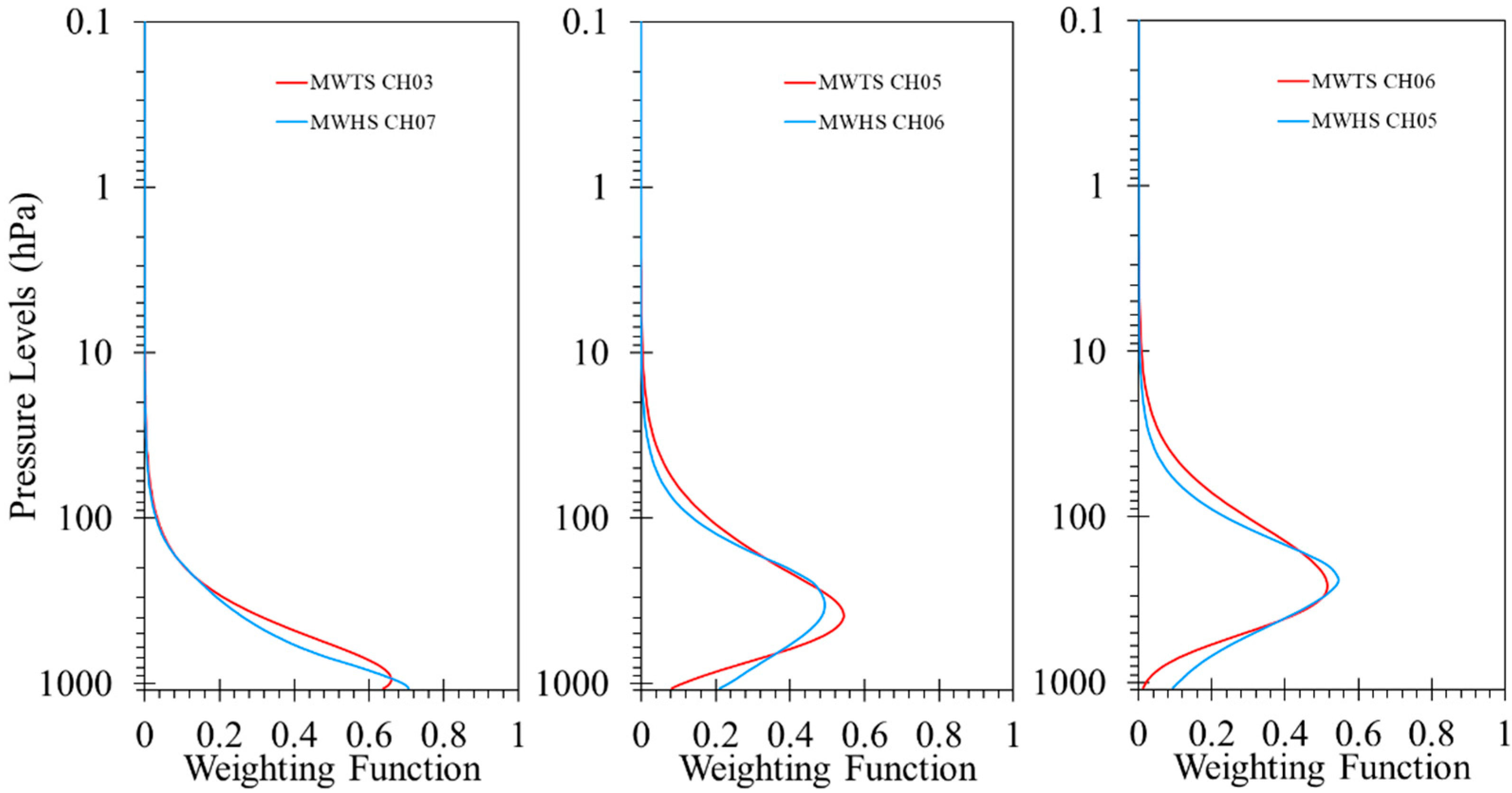
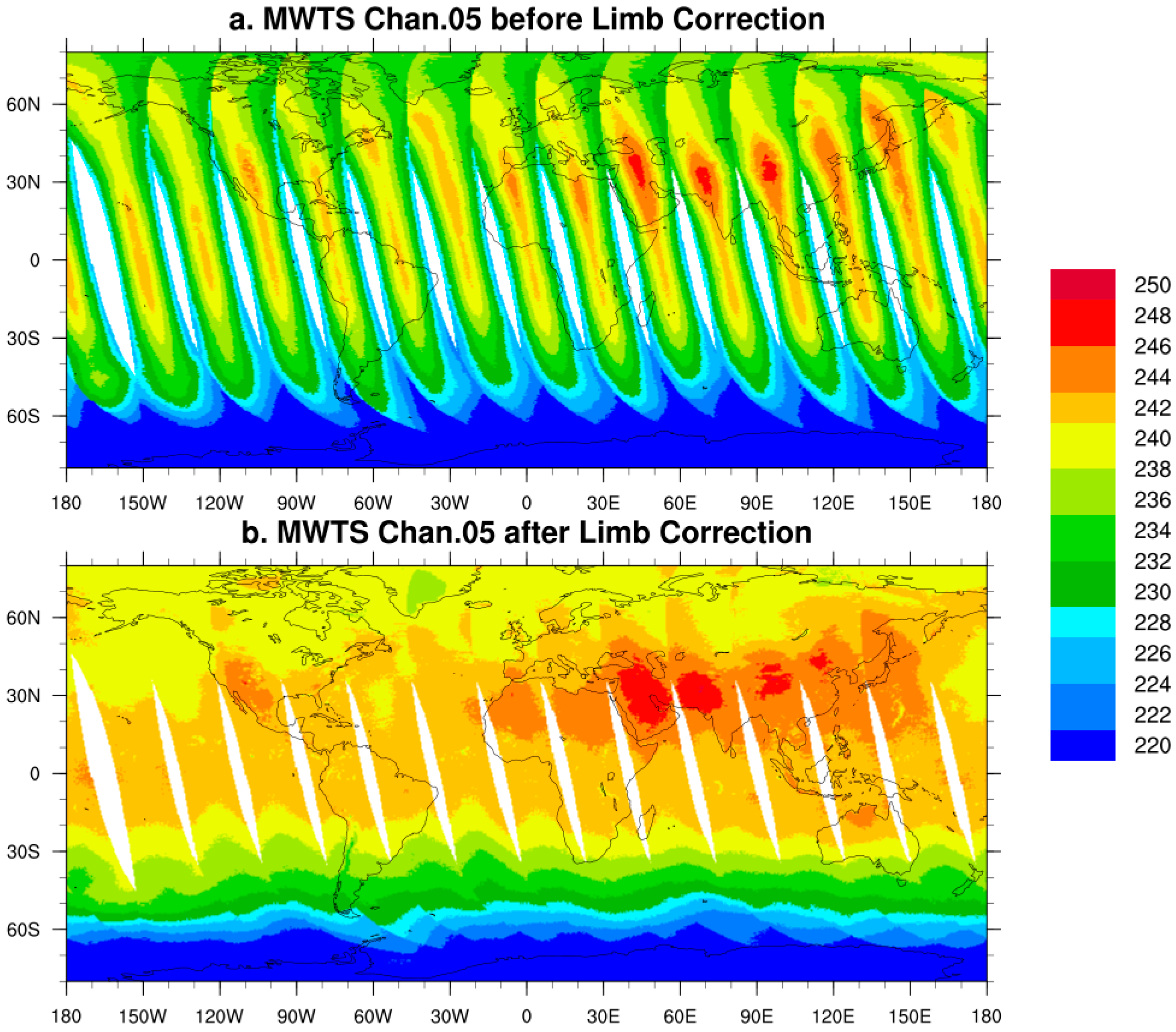
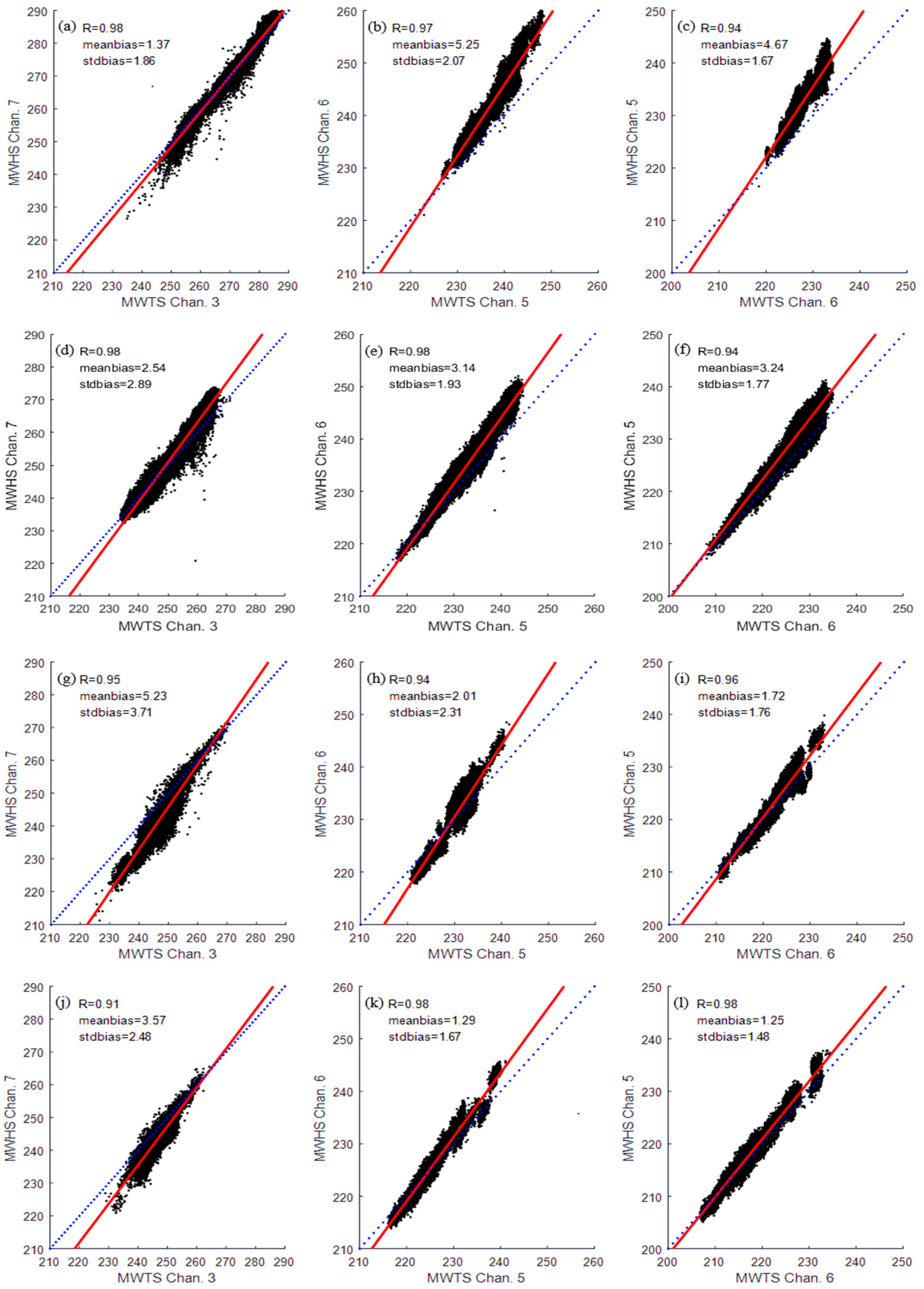
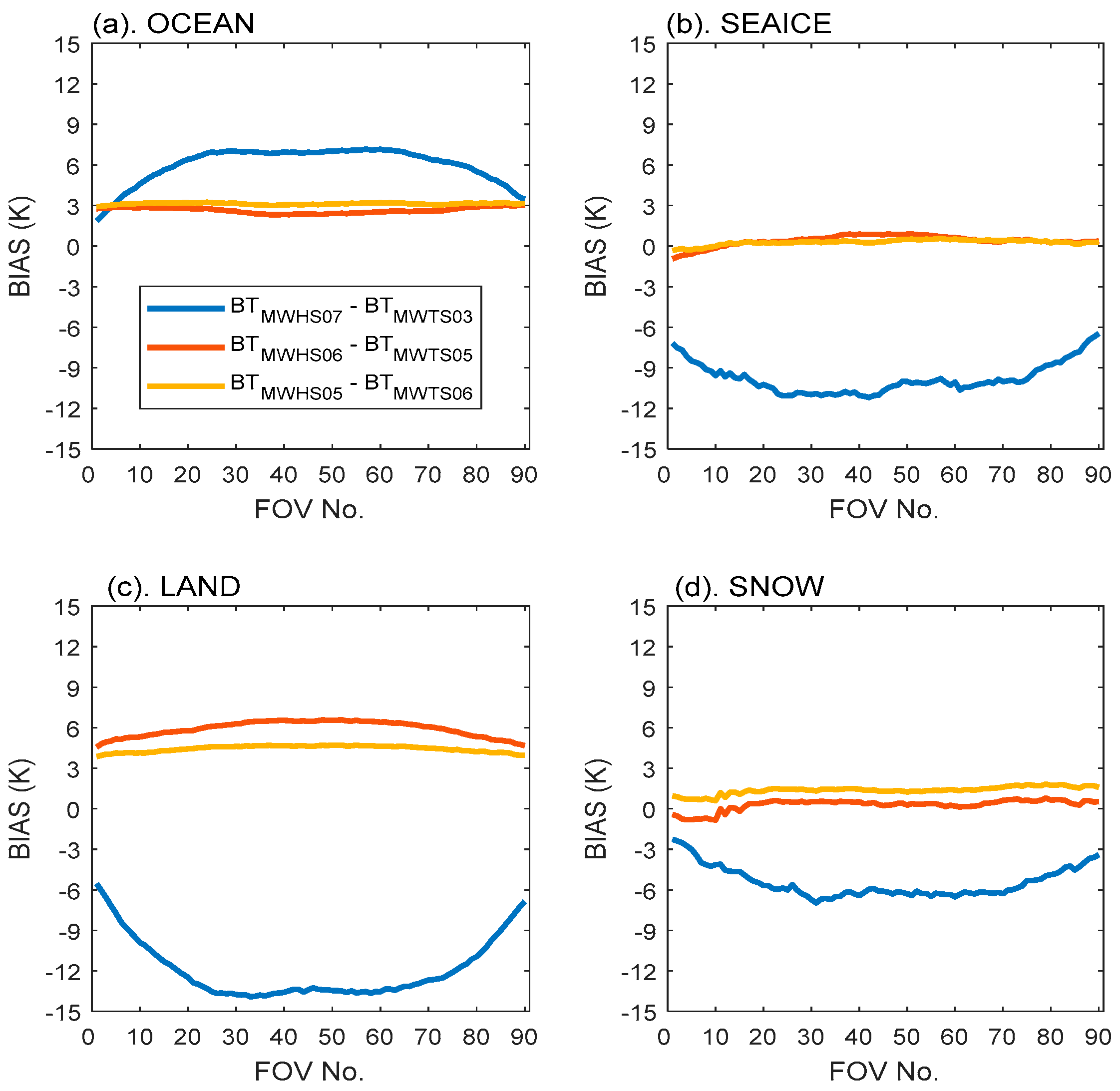
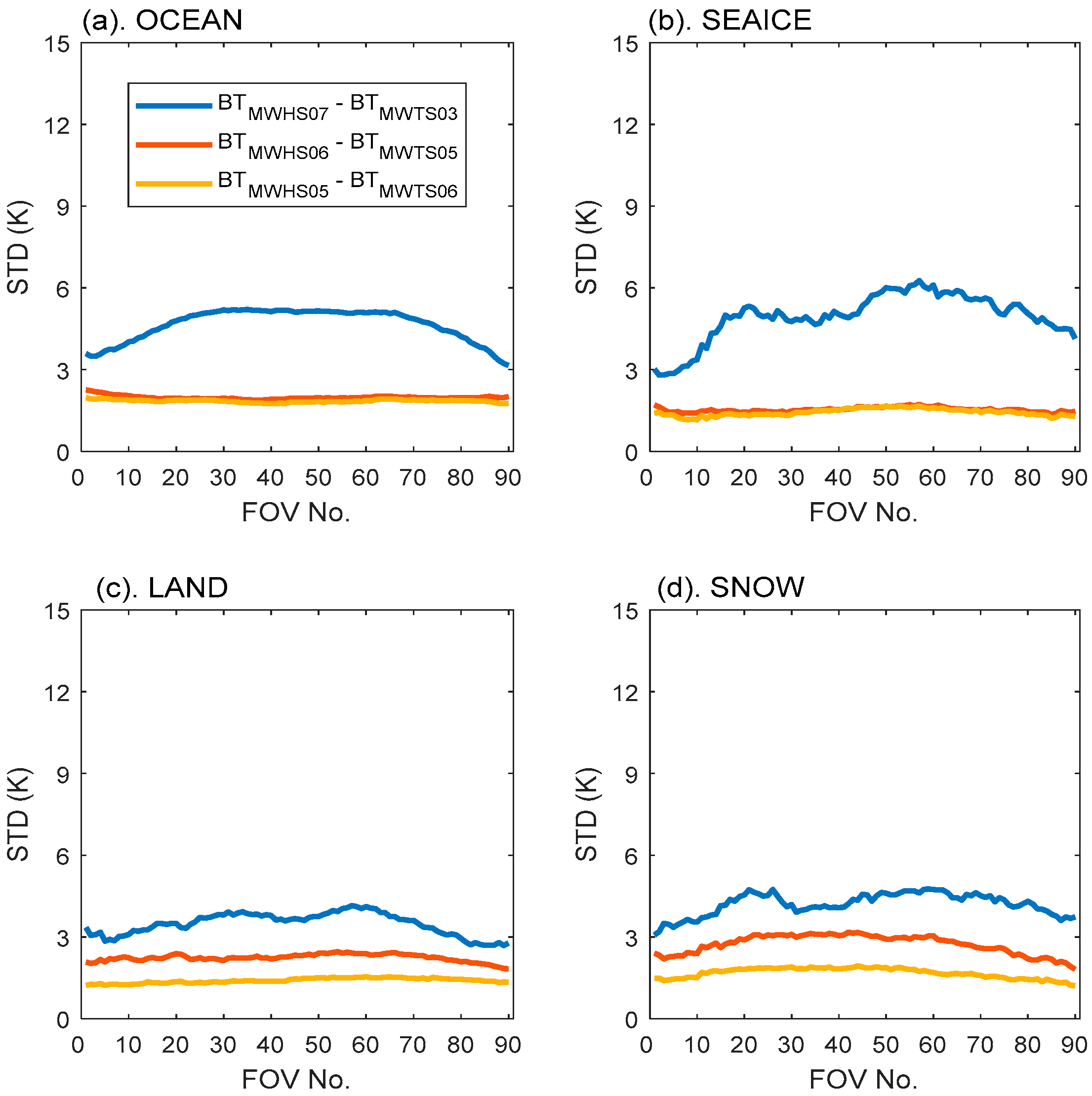
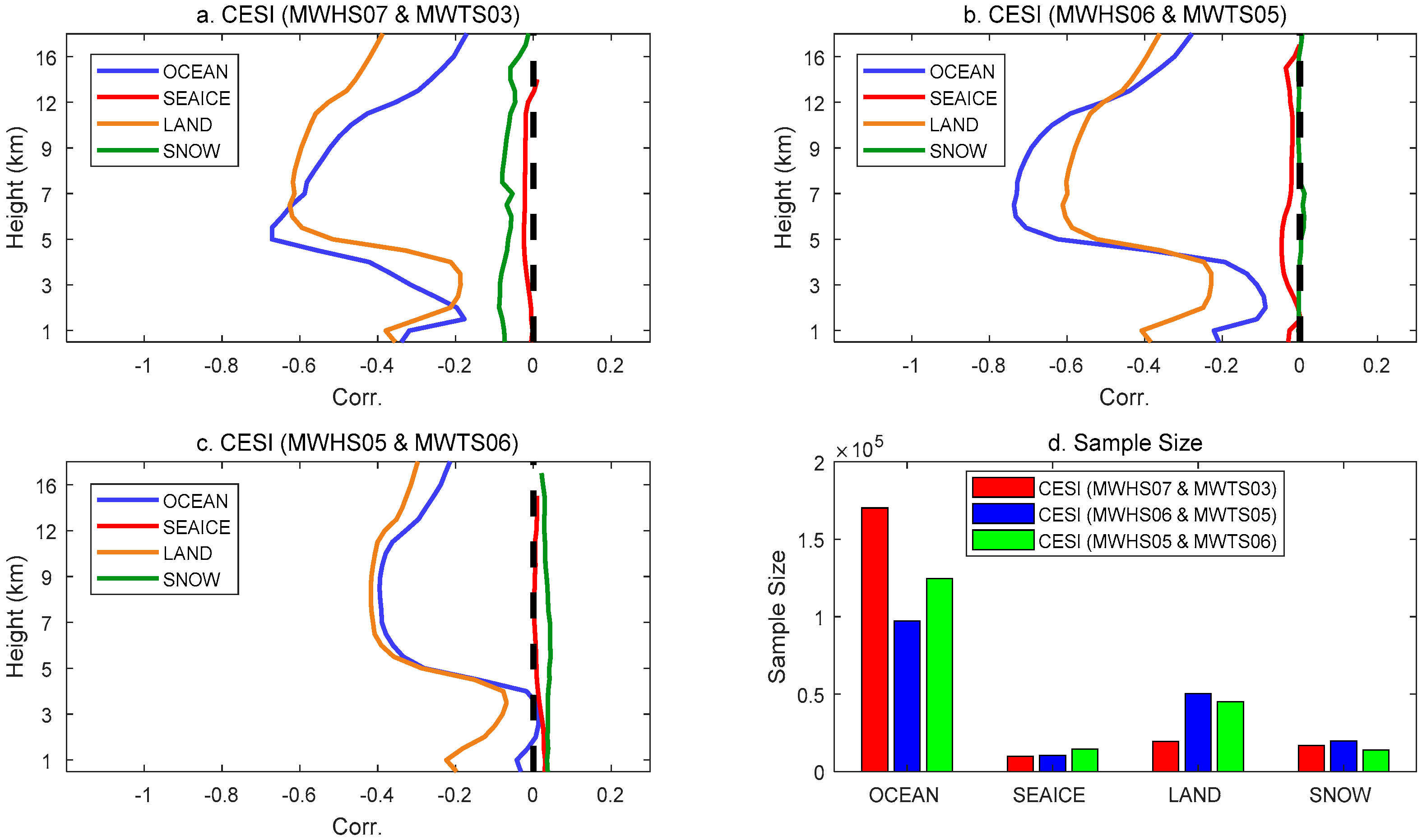

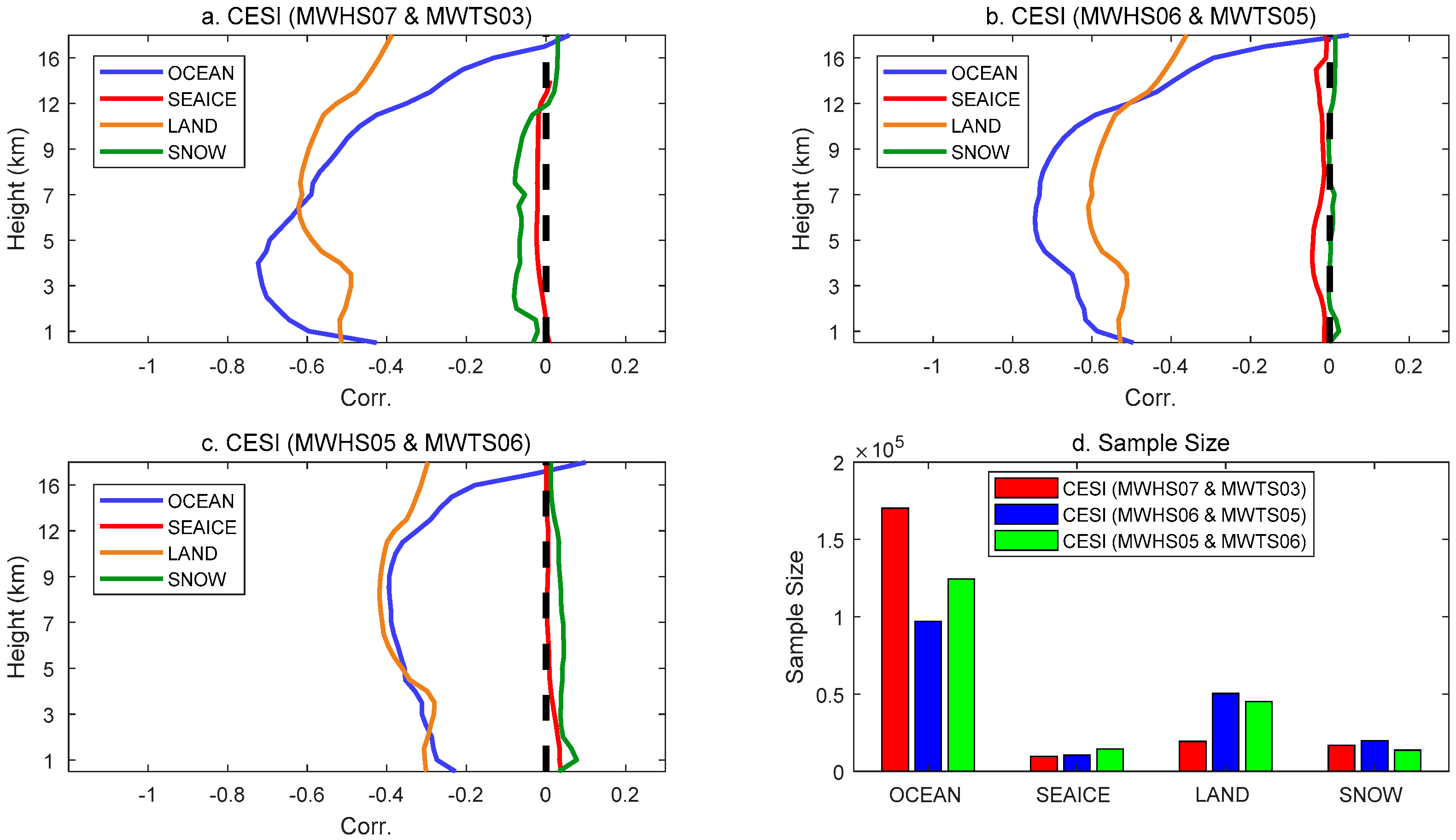
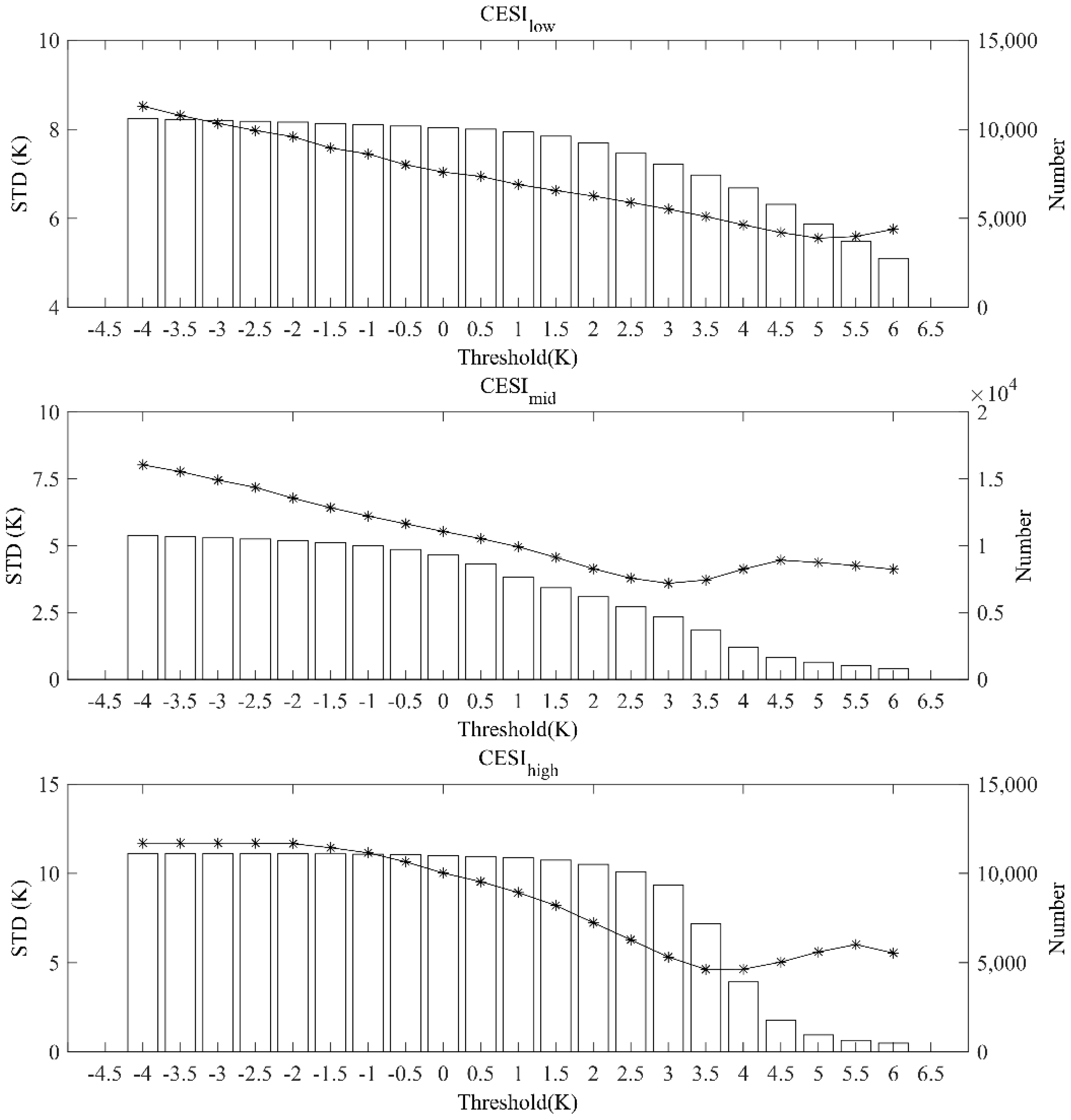

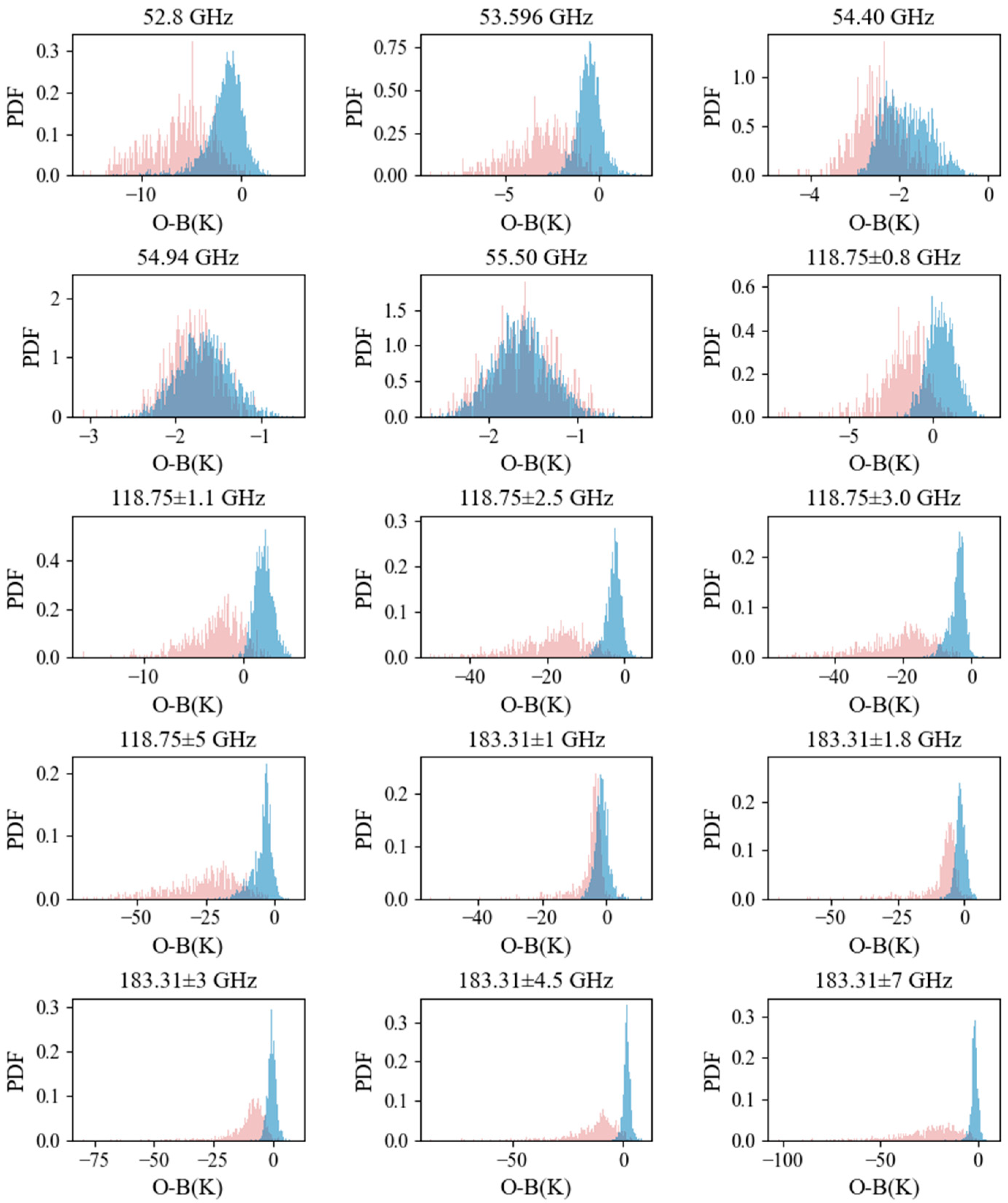
| Channel | Frequency (GHz) | Polarization | Channel | Frequency (GHz) | Polarization |
|---|---|---|---|---|---|
| ATMS 1 | 23.8 | QV | - | - | - |
| ATMS 2 | 31.4 | QV | - | - | - |
| ATMS 3 | 50.3 | QH | MWTS 1 | 50.3 | QH |
| ATMS 4 | 51.76 | QH | MWTS 2 | 51.76 | QH |
| ATMS 5 | 52.8 | QH | MWTS 3 | 52.8 | QH |
| ATMS 6 | 53.596 ± 0.115 | QH | MWTS 4 | 53.596 | QH |
| ATMS 7 | 54.4 | QH | MWTS 5 | 54.4 | QH |
| ATMS 8 | 54.94 | QH | MWTS 6 | 54.94 | QH |
| ATMS 9 | 55.5 | QH | MWTS 7 | 55.5 | QH |
| ATMS 10 | f0 = 57.29 | QH | MWTS 8 | f0 = 57.29 | QH |
| ATMS 11 | f0 ± 0.217 | QH | MWTS 9 | f0 ± 0.217 | QH |
| ATMS 12 | f0 ± 0.3222 ± 0.048 | QH | MWTS 10 | f0 ± 0.3222 ± 0.048 | QH |
| ATMS 13 | f0 ± 0.3222 ± 0.022 | QH | MWTS 11 | f0 ± 0.3222 ± 0.022 | QH |
| ATMS 14 | f0 ± 0.3222 ± 0.010 | QH | MWTS 12 | f0 ± 0.3222 ± 0.010 | QH |
| ATMS 15 | f0 ± 0.3222 ± 0.0045 | QH | MWTS 13 | f0 ± 0.3222 ± 0.0045 | QH |
| ATMS 16 | 88.2 | QV | MWHS 1 | 89.0 | QV |
| - | - | - | MWHS 2 | 118.75 ± 0.08 | QH |
| - | - | - | MWHS 3 | 118.75 ± 0.2 | QH |
| - | - | - | MWHS 4 | 118.75 ± 0.3 | QH |
| - | - | - | MWHS 5 | 118.75 ± 0.8 | QH |
| - | - | - | MWHS 6 | 118.75 ± 1.1 | QH |
| - | - | - | MWHS 7 | 118.75 ± 2.5 | QH |
| - | - | - | MWHS 8 | 118.75 ± 3.0 | QH |
| - | - | - | MWHS 9 | 118.75 ± 5 | QH |
| ATMS 17 | 165.5 | QH | MWHS 10 | 150.0 | QV |
| ATMS 18 | 183.31 ± 7 | QH | MWHS 11 | 183.31 ± 1 | QH |
| ATMS 19 | 183.31 ± 4.5 | QH | MWHS 12 | 183.31 ± 1.8 | QH |
| ATMS 20 | 183.31 ± 3 | QH | MWHS 13 | 183.31 ± 3 | QH |
| ATMS 21 | 183.31 ± 1.8 | QH | MWHS 14 | 183.31 ± 4.5 | QH |
| ATMS 22 | 183.31 ± 1 | QH | MWHS 15 | 183.31 ± 7 | QH |
| Pair | Channel Number | Central Frequency (GHz) | Weighting Function Peak (hPa) | Channel Number | Central Frequency (GHz) | Weighting Function Peak (hPa) |
|---|---|---|---|---|---|---|
| 1 | MWTS Ch3 | 52.80 | 940 | MWHS Ch7 | 118.75 ± 2.5 | 1070 |
| 2 | MWTS Ch5 | 54.40 | 400 | MWHS Ch6 | 118.75 ± 1.1 | 340 |
| 3 | MWTS Ch6 | 54.94 | 250 | MWHS Ch5 | 118.75 ± 0.8 | 230 |
Publisher’s Note: MDPI stays neutral with regard to jurisdictional claims in published maps and institutional affiliations. |
© 2022 by the authors. Licensee MDPI, Basel, Switzerland. This article is an open access article distributed under the terms and conditions of the Creative Commons Attribution (CC BY) license (https://creativecommons.org/licenses/by/4.0/).
Share and Cite
Kan, W.; Hu, H.; Weng, F. An All-Sky Scattering Index Derived from Microwave Sounding Data at Dual Oxygen Absorption Bands. Remote Sens. 2022, 14, 5332. https://doi.org/10.3390/rs14215332
Kan W, Hu H, Weng F. An All-Sky Scattering Index Derived from Microwave Sounding Data at Dual Oxygen Absorption Bands. Remote Sensing. 2022; 14(21):5332. https://doi.org/10.3390/rs14215332
Chicago/Turabian StyleKan, Wanlin, Hao Hu, and Fuzhong Weng. 2022. "An All-Sky Scattering Index Derived from Microwave Sounding Data at Dual Oxygen Absorption Bands" Remote Sensing 14, no. 21: 5332. https://doi.org/10.3390/rs14215332





